List of coats of arms of the independent cities in Bavaria
The list of coats of arms of the independent cities in Bavaria with their sub-lists, which can be reached via the navigation bar below, contains - sorted according to the administrative structure - the coats of arms of the independent cities in Bavaria listed in Wikipedia .
One district cities
| city | coat of arms | Comments |
|---|---|---|
On the mountain
|
 |
Coat of arms tour since the 14th century: "Divided; above in black a growing, red crowned and red armored golden lion, below the Bavarian diamonds. " |
Ansbach
|
 |
The use of coat of arms since the 14th century, evidenced by the use of seals since 1393: "A silver inclined wave bar in green, covered with three blue fish swimming one behind the other." |
Aschaffenburg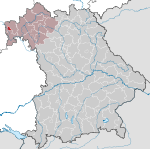
|
 |
Coat of arms since the 13th century. King Ludwig I confirmed the coat of arms on April 1, 1836 in the form of the oldest seal image. The colors have been fixed since 1839: “In silver, a red castle with round side towers and blue roofs; in the cloverleaf-shaped archway St. Martin, enthroned, clad in blue, with a silver pallium and blue miter, his right hand raised in blessing, with his left hand holding the golden crook. " |
augsburg
|
 |
The coat of arms is derived from the seal image; Seal guide known since the 13th century. Current version since 1811: "In a shield split by red and silver, a green stone pine nut on a golden capital, which is covered with a crowned head." For some time now, the city of Augsburg has used the coat of arms without the golden head. |
Bamberg
|
 |
Coat of arms management since the 13th century; documented from seal management since 1279. Current version approved by the city council on May 28, 1953: “In red a standing knight in silver armor with a red cross on his chest and a silver long sword on his belt; in the right a lance with a silver flag, on it a red cross, the left leaning on a blue shield with a silver eagle. " |
Bayreuth
|
 |
Awarded by Margrave Albrecht Achilles of Brandenburg with a privilege of December 22, 1457; evidenced by seal management since 1429: “Quartered and covered with two diagonally crossed rods, the right one black, the left one silver; 1 and 4 again quartered by silver and black; 2 and 3 in gold with a border decorated with red and silver, a red crowned and red armored black lion. " From 1819 to 1840 the Zollernvierung showed the colors silver and blue, the lion was red in a black field. |
Coburg
|
 |
Coat of arms since the 13th century, evidenced by seal management since 1272: "In gold, a black moor's head with a gold earring." Changes to the coat of arms: In the 13th century a battlement wall with a tower, flanked by a house and a hen. In the 14th century, twice the lion of Meissen and Thuringia in the quartered shield. From 1934 to 1945 the Mohrenkopf was replaced by an SA dagger with a swastika in the pommel. |
gain
|
 |
Awarded by Margrave Christian Ernst von Brandenburg-Kulmbach in 1707, confirmed by a document issued by the government of Middle Franconia on March 14, 1972: “Divided and split above; in front in silver a golden crowned and reinforced, red-tongued red eagle with golden clover stems and a breastplate embroidered in silver and black; behind, in silver, a gold crowned and armored, red-tongued black eagle with a gold neck crown, clover stems and the gold capital letters E and S on the chest; below, growing in blue over a silver battlement wall, a double-tailed, golden crowned, red-tongued golden lion. " |
Fuerth
|
 |
The use of coats of arms since the 16th century, evidenced by the use of seals since 1562. Awarded in 1818, amended by decree on March 13, 1939: "In silver a three-leaf clover leaf." Changes to the coat of arms: 1723 three stalked clovers on Dreiberg, after 1792 with the Brandenburg eagle. 1818 to 1939 with a green oak branch. |
court
|
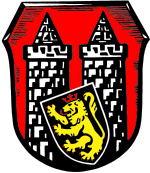 |
Coat of arms since the 14th century, evidenced by seal management since 1335: “In red, two silver tin towers with pointed roofs; On top of them a black shield leaning against them, in it a red crowned and red armored golden lion. " Changes to the coat of arms: Since 1571, two wild men and an angel standing behind the lion's shield appear. From 1820 to 1840 the two towers were connected with a gable. Re-adoption of the old coat of arms in 1960, confirmed by a ministerial resolution of June 10, 1960. |
Ingolstadt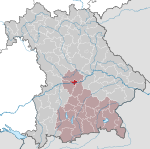
|
 |
Coat of arms since the 13th century. The coat of arms is handed down in the seal; Seal guide documented since 1294; Seal with the panther only since about 1340: "In silver, a fire-breathing blue panther." |
Kaufbeuren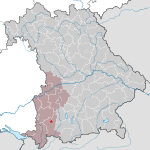
|
 |
Coat of arms since the 13th century, evidenced by the use of seals since 1295. The coat of arms has been handed down in its current form since 1449. Awarded by a ministerial resolution of the Ministry of the Interior on June 23, 1926: “Split by gold and red; at the front of the gap a half black eagle, at the back a golden sloping bar separated from two six-pointed golden stars. " Coat of arms changes: From 1818 to 1892 the eagle was missing. |
Kempten (Allgäu)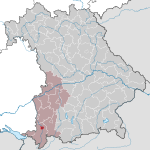
|
 |
Coats of arms since the 14th century, evidenced by seals since 1379. Awarded January 5, 1819: “Split; of black and silver; at the front at the gap a half golden eagle, at the back on a green three-mountain a red pinnacle tower with an open gate. ”→ Details Coat of arms changes: 1488 split of gold and black, covered with the double-headed eagle in mixed up colors. |
Landshut
|
 |
Coat of arms since the 13th century. The coat of arms is handed down in the seal; Seal management since 1275 shows: "In silver three, two-to-one, blue iron hats with intertwined red storm straps." |
Memmingen
|
 |
The use of coat of arms since the 13th century, evidenced by the use of seals since 1286: “Split; in front in gold a half, red armored black eagle at the slit, behind in silver a continuous red paw cross. ”→ Details |
Munich
|
 |
Coat of arms management since the 13th century; the small coat of arms has been documented since 1304 and, according to the city council resolution of December 17, 1957, is the only city coat of arms: Small coat of arms: “In silver, a standing monk with a gold bordered black robe and hood and red shoes, who holds a red book in his left hand; the right hand raised in a blessing. ” The large city coat of arms is used exclusively for representative purposes. → Details |
Nuremberg
|
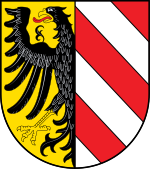 |
Coat of arms tour since the 13th century: Small coat of arms: “Split; in front in gold a half, red-tongued and gold-armored black eagle at the gap, in the back five times diagonally divided by red and silver. " |
Passau
|
 |
Coat of arms since the 13th century. The coat of arms is handed down in the seal; Seal management since 1368 proves: "In silver, a soaring red wolf." |
regensburg
|
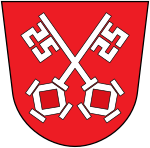 |
Coat of arms since the end of the 13th century. The coat of arms is derived from the seal image; Seal guiding since the late 12th century shows: "Two slanted silver keys in red." |
Rosenheim
|
 |
Coat of arms management since the 14th century. The coat of arms is handed down in the seal; Seal management since 1374 reliably proven: "In red a silver heraldic rose with a golden lug and green sepals." |
Schwabach
|
 |
Coat of arms since the 14th century, evidenced by the use of seals since 1329, confirmed by ministerial resolution of July 1, 1953: "In red on a silver arch, a silver tin tower covered with blue, on the right side by a golden shield, inside a red armored black eagle, left by a blue shield, inside a red armored golden lion between golden shingles." Coat of arms changes: 1371 two beer pots and the Zollernvierung. In the 15th century, the castle count's lion, the Zollernvierung and the two beer taps. 1806 instead of the castle count's lion the Palatinate-Bavarian diamond, instead of the Zollernvierung the Bavarian diamond. |
Schweinfurt
|
 |
The use of coat of arms since the 13th century, evidenced by the use of seals since 1309: "A silver eagle in blue." |
Straubing
|
 |
Coat of arms since the 13th century. The coat of arms is handed down in the seal; Seal guidance documented since the late 13th century; renewed 1952: “In red a silver plow; Above one another two labels with Bavarian diamonds, below a golden heraldic lily. " |
Pastures idOPf.
|
 |
Awarded by Elector Ludwig V and Count Palatine Friedrich II of the Electoral Palatinate with a coat of arms of January 25, 1510: “Divided and split above; in front in black a red crowned, red armored golden lion, behind the Bavarian diamonds; below in red on a green three-mountain a green pasture. " |
Wurzburg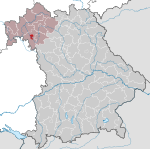
|
 |
The use of coat of arms since the 12th century, evidenced by the use of seals since 1195: "In black an inclined, notched flag, quartered in red and gold, on a silver lance pole." |
References and comments
- HdBG
- Entry on the coat of arms in the database of the House of Bavarian History
- ^ HdBG : City of Amberg
- ^ HdBG: City of Ansbach
- ^ HdBG: City of Aschaffenburg
- ^ HdBG: City of Augsburg
- ^ HdBG: City of Bamberg
- ^ HdBG: City of Bayreuth
- ^ HdBG: City of Coburg
- ^ HdBG: City of Erlangen
- ^ HdBG: City of Fürth
- ^ HdBG: City of Hof
- ^ HdBG: City of Ingolstadt
- ^ HdBG: City of Kaufbeuren
- ↑ HdBG: City of Kempten (Allgäu)
- ^ HdBG: City of Landshut
- ^ HdBG: City of Memmingen
- ↑ a b HdBG: City of Munich
- ↑ § 5 (1) of the statutes of the state capital of Munich on the use of the city arms (city arms statute - STWS) of December 2, 2002
- ↑ a b HdBG: City of Nuremberg
- ^ HdBG: City of Passau
- ^ HdBG: City of Regensburg
- ^ HdBG: City of Rosenheim
- ^ HdBG: City of Schwabach
- ^ HdBG: City of Schweinfurt
- ^ HdBG: City of Straubing
- ↑ HdBG: City of Weiden idOPf.
- ^ HdBG: City of Würzburg
